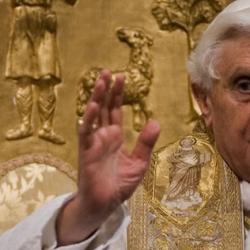One Corinthians 13-14 includes a cluster of musical metaphors. Paul compares the tongue-speaking of the loveless as a “noisy gong or a clanging cymbal” (13:1), and insists that tongues need interpretation by noting that you can’t know the tune without distinct tones (14:6-8). A few notes on what Paul’s analogies might contribute to a theology of music.
For starters, it’s significant that Paul introduces these musical analogies in a section of Corinthians dealing with “spiritual gifts” (12:1). The connection between the Spirit and music is implicit in 14:6-7. Speaking in tongues is inspired by the Spirit; but that Spirit-inspired sound must be articulated and interpreted in order to edify the church—just as notes must be articulated and distinguished in order to make knowable music. The underlying premise is that the Spirit’s work in edifying the church bears some analogy to music. That is more explicit elsewhere in Paul: Be filled with the Spirit . . . singing and making melody from the heart to the Lord (Ephesians 5:18-19). We may speak of a pneumatology of music.
Second, more explicitly, Paul’s analogy assumes a similarity between speech and music. Paul would seem to have some sympathy for efforts to work out a “grammar” of music. Distinguished tones are similar to speech. But not all spoken sound is analogous to music. Music is similar only to speech that communicates (that is, tongues that are explained by revelation, knowledge, prophecy, teaching, 14:6).
That implies, third, that music is communicative. Paul makes this explicit in verse 8. Tongues without interpretation is like a bugle whose notes are indistinguishable; a single blare of the bugle doesn’t summon anyone to battle. You listen for the tones that communicate preparation for battle. Music doesn’t simply evoke moods. It delivers messages.
Fourth, the response to musical messages, as Paul sees it, is less cerebral than pragmatic. The trumpet blast doesn’t communicate by stirring ideas in the heads of hearers. The trumpet blast communicates by rousing the hearers to action. In a Wittgensteinian fashion, music is understood when one acts according to the message of the music. Music speaks “Slab!” to the bricklayer. (This doesn’t exclude, of course, the reality of pictorial and cerebral responses to music; tone poems are clearly possible because they are actual. We do imagine a river when we hear the Moldau. Paul’s emphasis, though, is not on the indicative but on the imperative power of music, its ability of music to command.)
Finally, the use of a musical analogy at the beginning of Paul’s great love chapter (1 Corinthians 13) is significant. Paul probably wasn’t opposed to percussion; cymbals were used in temple worship, after all (1 Chronicles 16:5, 42; Psalm 150:5). The emphasis should be on the “clanging” of the cymbal, and that is perhaps related to his observation about distinguished tones in 14:7. Without love, Paul says, the sound of someone speaking in tongues is like uncommunicative noise. We can venture this paraphrase of the implicit comparison: As distinct musical notes create a sound that communicates, so love lends harmony and melody to human speech and action. When guided by love, tongues don’t produce an irritating cacophony but an edifying polyphony. By its patience, humility, truthfulness, long-suffering, love turns feeding the poor, martyrdom, acts of piety into music, music that not only sets moods but articulates.
And from this we should probably circle back to pneumatology, for it is the Spirit who pours out the love that comes to expression in the symphony of good works and edifying speech.












